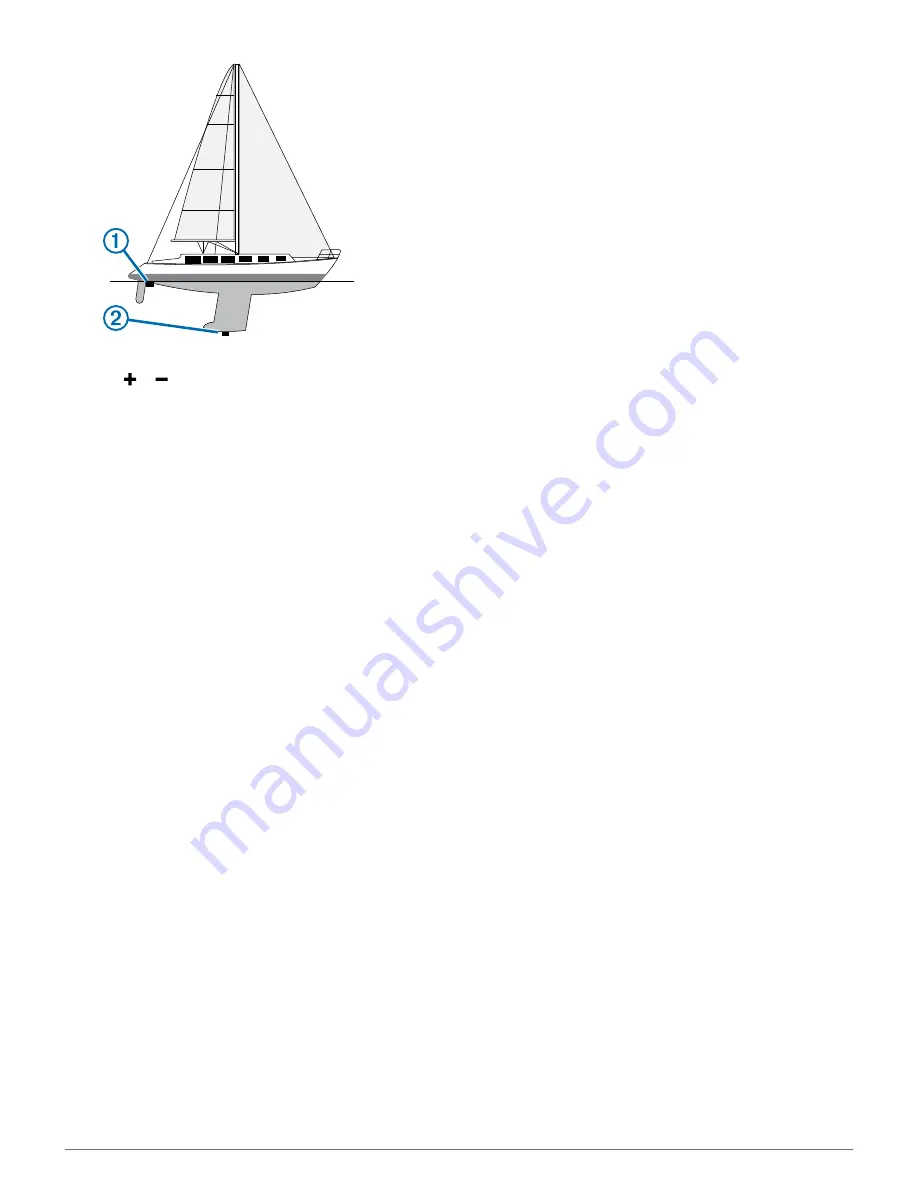
2
Select
Settings
>
My Vessel
>
Keel Offset
.
3
Select or based on the location of the transducer.
4
Enter the distance measured in step 1.
Setting the Water Temperature Offset
Before you can set the water temperature offset, you must have
a NMEA 0183 water-temperature sensor or a temperature-
capable transducer to measure water temperature.
The temperature offset compensates for the temperature
reading from a temperature sensor.
1
Measure the water temperature using the temperature
sensor or temperature-capable transducer that is connected
to the chartplotter.
2
Measure the water temperature using a different temperature
sensor or a thermometer that is known to be accurate.
3
Subtract the water temperature measured in step 1 from the
water temperature measured in step 2.
This is the temperature offset. Enter this value in step 5 as a
positive number if the sensor connected to the chartplotter
measures the water temperature as being colder than it
actually is. Enter this value in step 5 as a negative number if
the sensor connected to the chartplotter measures the water
temperature as being warmer than it actually is.
4
Select
Settings
>
My Vessel
>
Temperature Offset
.
5
Enter the temperature offset calculated in step 3.
Calibrating a Water Speed Device
If you have a speed-sensing transducer connected to the
chartplotter, you can calibrate that speed-sensing device to
improve the accuracy of water-speed data displayed by the
chartplotter.
1
Select
Settings
>
My Vessel
>
Calibrate Water Speed
.
2
Follow the on-screen instructions.
If the boat is not moving fast enough or the speed sensor is
not registering a speed, a message appears.
3
Select
OK
, and safely increase the boat speed.
4
If the message appears again, stop the boat, and ensure the
speed-sensor wheel is not stuck.
5
If the wheel turns freely, check the cable connections.
6
If you continue to get the message, contact Garmin product
support.
Other Vessels Settings
When your compatible chartplotter is connected to an AIS
device or VHF radio, you can set up how other vessels are
displayed on the chartplotter.
Select
Settings
>
Other Vessels
.
AIS
: Enables and disables AIS signal reception.
DSC
: Enables and disables digital selective calling (DSC).
Collision Alarm
: Sets the collision alarm (
page 5
).
AIS-EPIRB Test
: Enables test signals from Emergency Position
Indicating Radio Beacons (EPRIB).
AIS-MOB Test
: Enables test signals from man overboard
(MOB) devices.
AIS-SART Test
: Enables test transmissions from Search and
Rescue Transponders (SART).
Restoring the Original Chartplotter Factory
Settings
NOTE:
This will delete all settings information you have
entered.
Select
Settings
>
System
>
System Information
>
Factory
Settings
>
Reset
.
Chartplotter Data Management
Copying Waypoints, Routes, and Tracks to a
Chartplotter
Before you can copy data to the chartplotter, you must have the
latest version of MapSource® or HomePort™ software
programs loaded on your computer and a memory card installed
in the chartplotter.
Select an option:
• Copy the data from HomePort to the prepared memory
card.
For more information, see the HomePort help file.
• Copy the data from MapSource to the prepared memory
card.
For more information, see the MapSource help file.
Copying Data from a Memory Card
1
Insert a memory card into a card slot.
2
Select
Info
>
User Data
>
Data Transfer
>
Card
.
3
If necessary, select the memory card to copy data to.
4
Select an option:
• To transfer data from the memory card to the chartplotter
and combine it with existing user data, select
Merge from
Card
.
• To transfer data from the memory card to the chartplotter
and overwrite existing user data, select
Replace from
Card
.
5
Select the file name.
Copying Waypoints, Routes, and Tracks to a
Memory Card
1
Insert a memory card into the card slot.
2
Select
Info
>
User Data
>
Data Transfer
>
Card
>
Save to
Card
.
3
If necessary, select the memory card to copy data to.
4
Select an option:
• To create a new file, select
Add New File
, and enter a
name. The file name is saved with an .adm extension.
• To add the information to an existing file, select the file
from the list.
Chartplotter Data Management
25






































